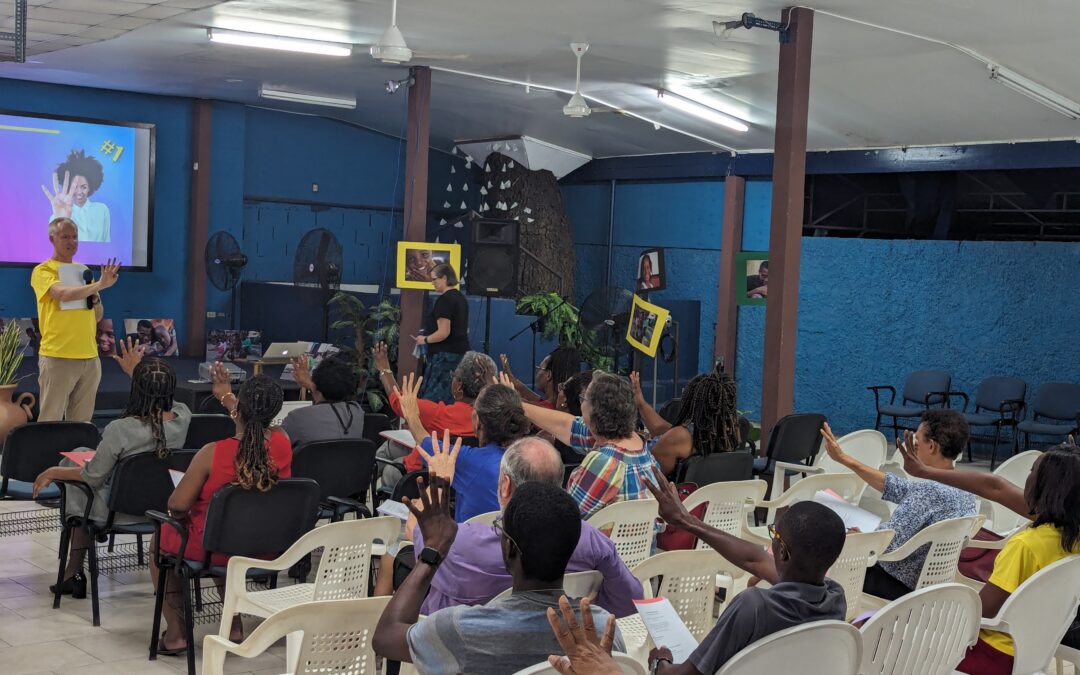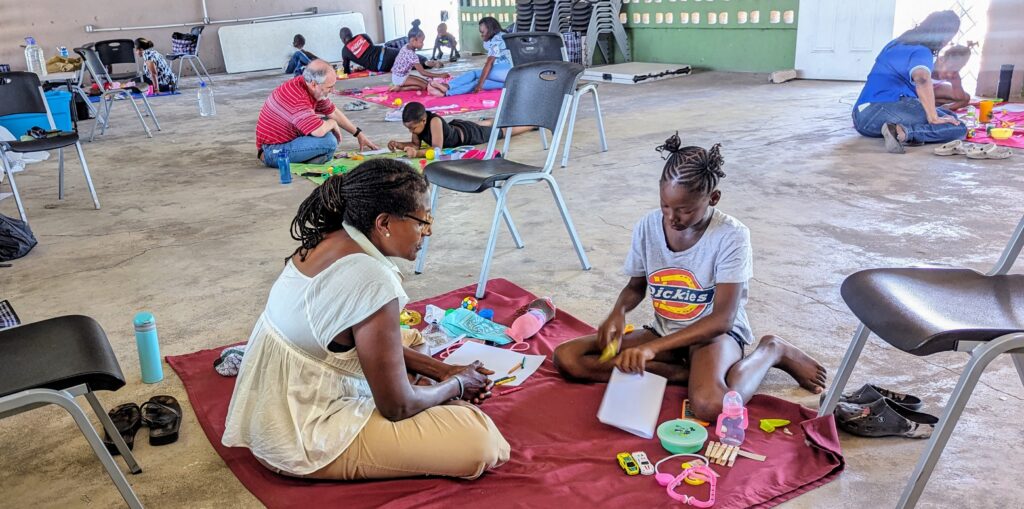I would like to ask you all to try something. Hold out your arm, with 4 fingers pointing up (like the group is doing in the photo above). Now hold those fingers directly between you and someone’s face (if you are the only person in the room, try it with a picture on the wall, and if you are not the only person in the room you’d better explain to the other person what you are doing!)
Now, imagine that your fingers represent problems that you are experiencing in the relationship with a child. When you focus on your fingers. What happens to the face beyond them?
Now focus on the face, without moving your arm … what happens to your fingers?
Assuming this worked, when you focussed on the fingers, the face would have been blurred … but when you focussed on the face, the fingers would have been blurred (and gone so out of focus that they would have separated into several blurred fingers).
This was a practical illustration that Jeanne Williams introduced us to over the last few weeks, as a way of reinforcing the most significant lesson that undergirded all the training we did in Jamaica over that time:
The key is to focus on the person, not on the problems.
The test of any training is whether it makes a difference on the ground … and this premise; that the most effective way to help a young person overcome problems is to focus on building a relationship where they know they are safe and where they are seen, rather than on the problems, was put to the test many times in the last few weeks … quite literally … on the ground.
In the photos below you will see the play mats on the ground, with the toys laid out for the “restorative play sessions” that we were training people to run. Then you will see some photos of the play sessions taking place. The cohort who were trained were able to deliver 40 restorative play sessions over the 5 days of training, none of which focused on any behaviour problems exhibited by any of the children, but instead focussed on the trainee being fully present and actively reflecting back the actions and emotions to the child for 30 minutes, as the child took the lead in that time of play. This gives the child the space they need to process whatever they need to process through play, and just to be present in the moment.
By the third day, when the restorative play sessions began, a peace just descended on the centre as the children just soaked up this attentive time. This continued for the fourth and fifth days. At the end of the week we asked the parents how their children were doing, and some of the answers were:
“She’s more happy.”
“He’s not giving any trouble this week.”
“I haven’t had to talk to him about any bad behaviour.”
“She has a calmer spirit.”
“She is peaceful.”
“He is talking a lot more openly.”
Many of the parents then came out to the parenting seminar, and were thirsty for the input because of the impact they had seen on their children. In all the years of working in Trench Town, we have not found it easy to get much interest from the fathers in coming out to interact with their children. So it was a real encouragement to have five fathers come to the parenting session, and really engage with the input and the exercises.
The volunteers training evening, and the one day training seminar for professionals who work with children followed a similar theme; people were really thirsty for the input.
The Foundations taster weekend saw the same thing again, the input was about living with God, others and yourself but there was such a thirst and engagement with the material that people really got a lot out of it.
One more story …
One moment that really highlighted the impact of focussing on the person, not on the problem, was at the end of the week of restorative play sessions. The bus had broken down, but all the children wanted to pile into the car instead to be dropped home. When we arrived at the first stop, some didn’t want to come out of the car because they wanted the others to be dropped home first. Then the others started arguing with them and pushing them out of the car, and then those who were getting pushed started to hit back on their way out of the car. After dropping the second group and returning to the centre, I found that two girls from the first group had walked back to the centre, and one was very upset and complaining loudly to Leo. It was a real discipline to focus on the person and not on the problem … because the problems were very evident that afternoon. However, during the week I had seen that this same girl was very responsible in how she had taken care of her play area, was very caring in how she had looked after the toy doll, and was very creative … so I just told her that I had seen those things in her. She stopped complaining, and by the time I told her she was creative she said; “Yes Sir, mi WELL creative!” The negative behaviour just disappeared, and she started being very kind to Leo instead. She then ran to the gate with her friend, then stopped and shouted, “Bye Sir!” with a massive smile and a wave. Building on the investment that had been made that week by focussing on her, and not focussing on the problems, meant she was suddenly back … and the problems were left to one side.
It was a great reminder of how powerful this approach can be.





Recent Comments